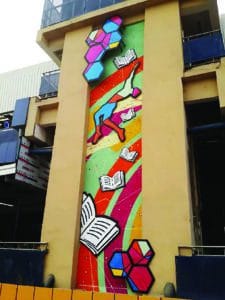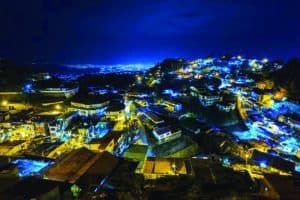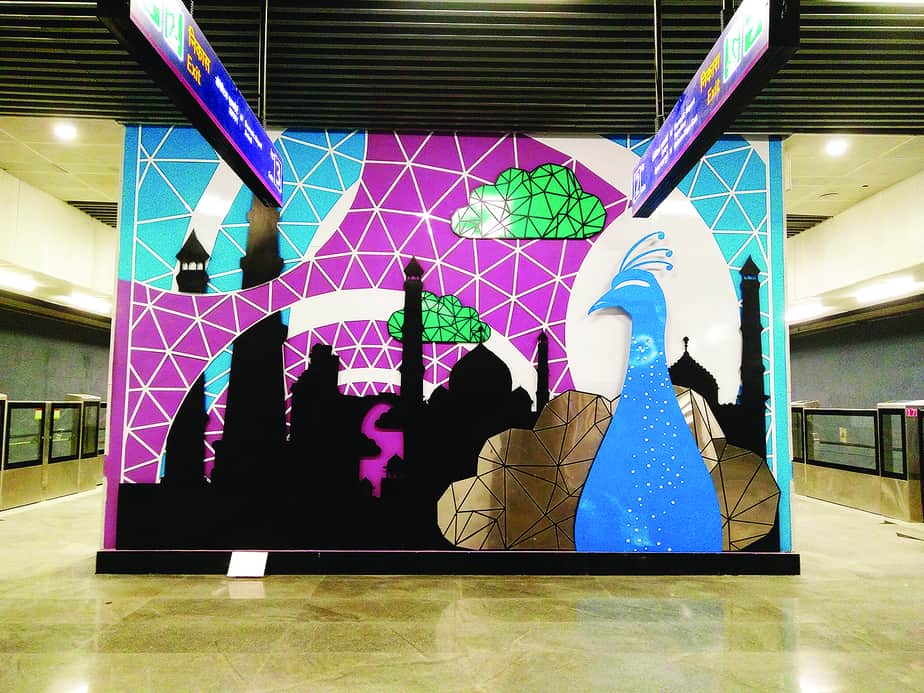Delhi Metro stations are transforming into hubs of exhibitions and artworks to bring art one step closer to commuters
As you walk out of Delhi airport Terminal 1D, and take a Metro at the newly opened Magenta line , you simply can’t miss the bright blue peacock mural with iconic landmarks of Delhi in the background. These are part of the several artworks and exhibitions taking place at the capital’s Metro stations, to bring art closer to people.
“The aim is to not restrict art to elite drawing rooms and bring them to public spaces, making it more accessible,” says Shubra Chaturvedi, the painter of the murals titled ‘Delhi Hues’, the installations at the airport Metro pay tribute to the city. In terms of location, the placement of these murals is significant as the airport is the entry point to a city and it gives a peak to the capital’s rich heritage, its history and also what to expect from the city. A montage of the quintessential motifs, it displays silhouettes of Qutub Minar, Red Fort, India Gate and others.
“DMRC endeavours to promote art and culture through artworks, display panels and exhibits at its stations. Since Metro stations are points of intersection of various regions and cultures, these provide a visual hook for appreciating the history of the city. Mural work infuses life into concrete and iron structures by breaking the monotony and making the surroundings pleasant,” says a Metro official.

The artworks of a particular station are created keeping in mind the area in which it is situated, its people, history and the notable landmarks around it. For instance, the installations in Janpath pays a tribute to three elements — the Jan (people) and the two historical monuments in the vicinity — Agrasen Ki Baoli and Jantar Mantar. Another work of Chaturvedi at the Jamia Millia station, titled, ‘Khwaboon ka Karvaan’ was made to acknowledge the contributions of the teachers and students of Jamia Millia Islamia.
“Art has to be simple”, says Chaturvedi. In an effort to make it more interactive she adds layers to her work to give perspective and drama. “The works are given mirror or chrome finish along with bright and vibrant colours so that they catch people’s attention and compels them to engage with it,” she adds.
The installations at various stations are characterised by a variety of materials including paint, metal, fibre glass, print on vinyl or canvas and others, as per the requirement of the artwork. The artwork in Central Secretariat station, ‘You are Here’, uses mirrors and lights in different angles. Drawing inspiration from the Delhi Metro network map, it gives commuters a feeling as if they are present at several places at the same time.
Not only murals, even exhibitions are being hosted at Metro stations to transform these transit points into art hubs. Metro has collaborated with India Habitat Centre, under the “Art in the Metro’ initiative to organise regular exhibitions at two main Metro stations, Mandi House and Jor Bagh, in a joint endeavour to showcase art in public spaces.
“It’s an effort to sensitise the public towards arts and aesthetics, especially those who either do not have time or are reluctant to go to formal spaces of art display. In addition, it brings in joy, beauty and colour to the life of everyday commuters ,” says Alka Pande, curator of Visual Arts Gallery IHC, who is in-charge of organising the exhibitions in the stations.
The ongoing exhibition at Jor Bagh station, titled, ‘Paani Pahaar- Water of the Himalayas’, explores the changing landscapes and escalating water crises of the Indian Himalayas. It is based on the changing patterns of land-use and development in the lower Himalayas of India and Nepal, and how they are impacting the ways in which small towns throughout this region source and distribute water. The exhibition includes collaborators from India and Nepal and curated archival prints from the University Library and Centre for South Asian Studies.

A lot of thought is given while selecting the work to be displayed at the station. “There is a limitation in the medium of display and space. Most of the works are printed on vinyl so that they can be backlit as light boxes,” explains Alka. The themes are centred around sustainable development and cultural history both ancient and contemporary.
The other exhibition at Mandi House is called ‘Because we all love our homes’ and will be showcasing ideas around sustainability and environment. There is an interactive piece with four light boxes which displays an arid land in the scorching sun with the message, ‘Let’s create a better environment piece by piece’. The text encourages the commuters to take off a piece of the arid land. Once a piece is taken off, the reverse side explains that it is made of seed paper and one can plant it in soil. The idea is to have more and more people take of the pieces and plant them near their homes or other places. Once the entire picture is taken off, piece by piece, a verdant jungle can be seen at the back conveying the transformation that can be achieved by planting more and more trees.
These installations are quite a hit among commuters. One can see a lot of people clicking photos and selfies and intently reading the curatorial note. “Delhi Metro has seen a lot of changes from the initial days of establishment. It has transformed into a modern sophisticated public space with smooth and shiny interiors”, says Siraj Bhattacharya, a regular Metro commuter.





